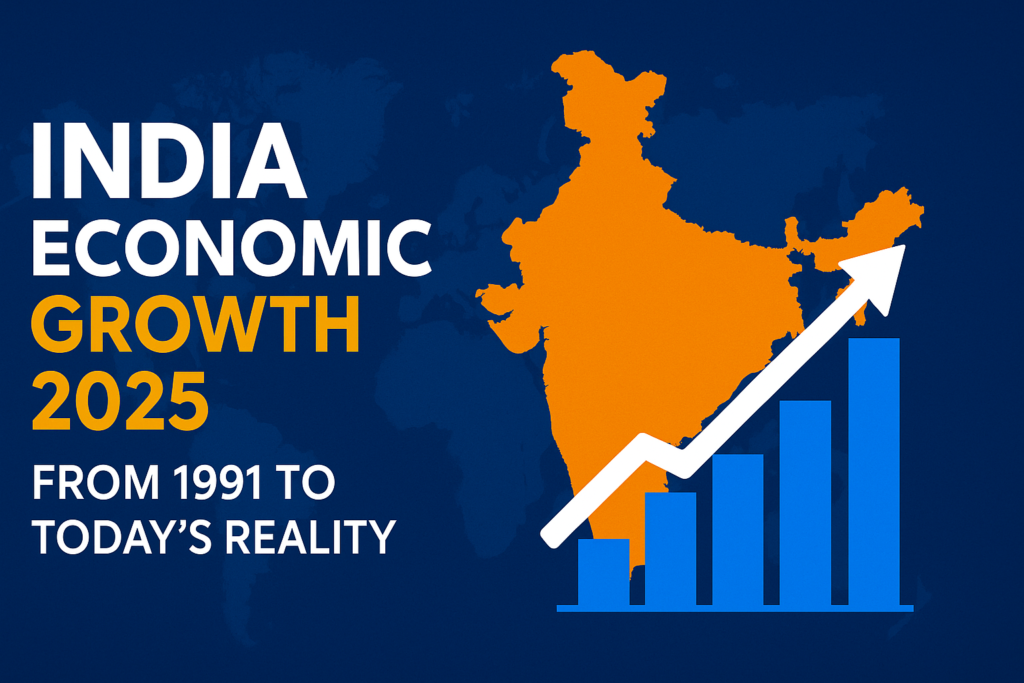India Economic Growth 2025: From 1991 to Today's Reality
Introduction
Back in 1991, India was facing a serious economic crisis. The country had very little money left to import essential goods. To address the situation, under the prime minister of P.V. Narasimharao and finance minister Dr. Manmohan Singh, the government decided to open up the economy. This led to big changes in how businesses worked and how India traded with the world.1991 marked the dawn of liberalization, privatization, and globalization (LPG) reforms, which fundamentally reshaped India’s economic growth. Now, in 2025, India is one of the biggest economies in the world. Over three decades later, the question is, has India really developed, or is it just looking good on paper? now, let’s see how India has grown up. the progress of India’s economy commenced when the LPG formula was introduced by the government. so, what is the LPG formula?
Table of Contents
ToggleWhat is the LPG formula, and how does it work?
1. Liberalization
Goal: To cut down government control and encourage private sector growth.
Key Changes:
* Removal of industrial licensing (except for a few industries).
* Reduction in tax rates and tariff barriers which help to open manufacturing industries in india.
*Easier norms for foreign direct investment (FDI).
*Simplified procedures for starting and operating businesses
2 . Privatisation
Goal: To reduce the burden on the government and improve efficiency.
Key factors :
* Disinvestment in Public Sector Undertakings (PSUs).
* Encouraging private ownership in sectors like telecom, airlines, banking, etc.
* Greater role of market forces in determining prices and production.
3. Globalization
Goal: To integrate India’s economy with the global market.
Key Changes:
* Allowing foreign companies to invest and operate in India.
* Linking domestic economy with global trade and capital markets.
* Participated in World Trade Organization (WTO).
Why It Was Used in 1992:
India was facing a severe balance-of-payments crisis, high inflation, low foreign exchange reserves, and fiscal deficit. To overcome this and get help from the IMF and World Bank, India had to open up its economy.
What Happened in 1991 and the Start of Big Changes
In 1991, India faced a financial emergency. The government didn’t have enough money to pay for imports. So, under Finance Minister Dr. Manmohan Singh, India started economic reforms:
– Removed many restrictions on businesses
– Allowed more international trade and investment
– Sold some government-run companies to private players
– Reduced the value of the rupee to make exports more attractive
These steps helped connect India to the global market and set the stage for future growth.
Economic Transformation: A Statistical summary
The most visible impact of the post-1991 reforms has been on India’s economic growth. Before liberalization, India’s GDP growth rate was modest. However, the introduction of market-oriented policies spurred a period of high economic expansion.
GDP Growth: India’s GDP has grown significantly. In 1992, India’s GDP was around $288 billion. But by 2023, it is estimated to reach $3.55 trillion, making it one of the largest economies worldwide. The average GDP growth rate during the 2000s was particularly impressive, often exceeding 7%. Although there have been fluctuations, the overall trend is upward. The GDP growth rate for 2023 was 7.58%, up 0.6% from 2022.
Per Capita Income: Along with overall GDP growth, per capita income has also seen a substantial rise. From a middle of $318 in 1992, it reached approximately $2,485 in 2023. This increase reflects a higher standard of living for a larger section of the population, although significant disparities persist.
Mission to reduce Poverty: Economic growth has played a very crucial role in poverty reduction. The poverty rate, defined as the percentage of the population living below a certain income threshold, has declined considerably. Some reports even suggest a poverty rate below 5% in 2024. Notably, between 2005-06 and 2015-16, India lifted 271 million people out of extreme poverty. This progress is attributed to economic growth, increased access to welfare schemes, and improvements in the education and healthcare sectors.
Foreign investment and trade: Liberalization opened doors to foreign direct investment (FDI) and increased international trade. India has become an important destination for foreign investors in various sectors, contributing to capital inflow, technological advancements, and job creation. Total exports reached more than $36.43 billion in January 2025.
Social Progress: What’s Better and What’s Not
Poverty
India helped 415 million people come out of poverty between 2005 and 2021 (NITI Aayog Report, 2023). However, around 228.9 million people live in poverty.
Health and Education
– Life Expectancy: Went up from 58 years in 1990 to about 71 years in 2023
– Literacy Rate: Improved from 52% in 1991 to 77.7% in 2023
Still, India spends less than 2.5% of its total income on public health, which is low compared to other countries.
Growth in Technology and Infrastructure
India has made big moves in the tech world:
– Started Digital India in 2015
– Issued over 1.3 billion Aadhaar cards
– UPI (a digital payment system) handles over 10 billion transactions every month
– Launched 5G networks and smart city projects
India also became the third-largest startup hub in the world and successfully launched missions like Chandrayaan-3 and Aditya L1.
Problems: Jobs, Inequality, and Corruption
Even with growth, India faces serious challenges:
Unemployment crises
– Urban unemployment was around 7.5–8% in 2023
– Most people still work in the informal sector (no job security or benefits, and they can’t even get their salary on time)
Gap Between Rich and Poor
– The top 10% of people in India own 77% of the country’s wealth (Oxfam Report, 2023)
– Big differences still exist between rural and urban areas. even in 2025, the situation of indian villages is worse in terms of medical and infrastructure ( roads, highways, houses).
Corruption and crimes
India was ranked 93 out of 180 countries in the 2023 Corruption Index. Many scams and slow government processes still affect development. according to NCRB data ( National Crime Records Bureau )
🔸 Total Registered Crimes (NCRB 2022 Data):
IPC crimes: 60,96,310 cases
Special & Local Laws (SLL): 31,46,329 cases
🔸 Crime Rate (IPC):
445.9 crimes per 1 lakh population
U.P. and Maharashtra state are on the top list. major crimes happen against women in India. According to NCRB data in the year of 2021 during covid period more than 31000 rape cases were registered across the country means 86 rape in a day. however not all rape cases are true. but this number is insane.
So, Is India Truly Developed?
The answer isn’t simple. India has made a lot of progress in economy, technology, and global reputation. But real development also means good health, education, equal opportunities, and fair income — and India still has a long way to go. In the United Nations Human Development Index, India ranked 132 out of 191 countries in 2023, showing that human development is still behind.
Conclusion: Developed or a Myth?
India has made significant progress since 1992. Big cities, better roads, faster internet, and space missions show great progress. But millions of people are still struggling for basic needs like food, jobs, and healthcare.
So, is India fully developed? in my opinion, not yet. But the country is moving in the right direction. With the right steps, I know many things remain to change. It may take some time, but India can become not just a fast-growing economy but a place where everyone has a fair chance to grow.



